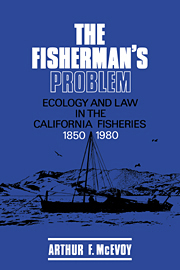Book contents
- Frontmatter
- Contents
- List of figures
- List of tables
- Preface
- Acknowledgments
- List of abbreviations
- Introduction
- I The miner's canary
- II Sun, wind, and sail, 1850–1910
- III The industrial frontier, 1910–1950
- 6 Mechanized fishing
- 7 The bureaucrat's problem
- IV Enclosure of the ocean, 1950–1980
- Conclusion
- Appendixes
- Notes
- Selected bibliography
- Index
7 - The bureaucrat's problem
Published online by Cambridge University Press: 06 January 2010
- Frontmatter
- Contents
- List of figures
- List of tables
- Preface
- Acknowledgments
- List of abbreviations
- Introduction
- I The miner's canary
- II Sun, wind, and sail, 1850–1910
- III The industrial frontier, 1910–1950
- 6 Mechanized fishing
- 7 The bureaucrat's problem
- IV Enclosure of the ocean, 1950–1980
- Conclusion
- Appendixes
- Notes
- Selected bibliography
- Index
Summary
It is not enough that information may be obtained upon which the fisheries may be managed so as to get from them the greatest sustained yield. This information must be used or it is effort largely wasted.
– N. B. Scofield (1938)“In modern societies,” wrote Justice Holmes in 1903, “every part is so organically related to every other that what affects any portion must be felt more or less by all the rest.” While he wrote in the context of economic competition between industries, Holmes's, use of biological imagery was appropriate: For reform-minded people of the Progressive Era, the depletion of natural resources symbolized better than any other contemporary problem the way in which an advanced industrial economy imposed serious external costs on society at large. Conversely, for Theodore Roosevelt, scientific conservation was the very soul of Progressivism. Roosevelt and others who led a remarkable wave of social reform between 1900 and 1920 believed that only scientific planning and economic efficiency, applied to human affairs through the deliberate use of centralized legal power, could preserve the future of a rapidly crowding, interdependent industrial society.
Late-nineteenth-century lawmakers had tried desperately to protect the liberty and dignity of individuals by using time-honored standards of property rights and limited government to draw clear boundaries between what belonged to private initiative exclusively and what fell within the reach of government's power to police in the public interest. The state-ownership rule of Geer v. Connecticut has been one not particularly elegant attempt to do this with respect to wildlife conservation.
- Type
- Chapter
- Information
- The Fisherman's ProblemEcology and Law in the California Fisheries, 1850–1980, pp. 156 - 184Publisher: Cambridge University PressPrint publication year: 1986

